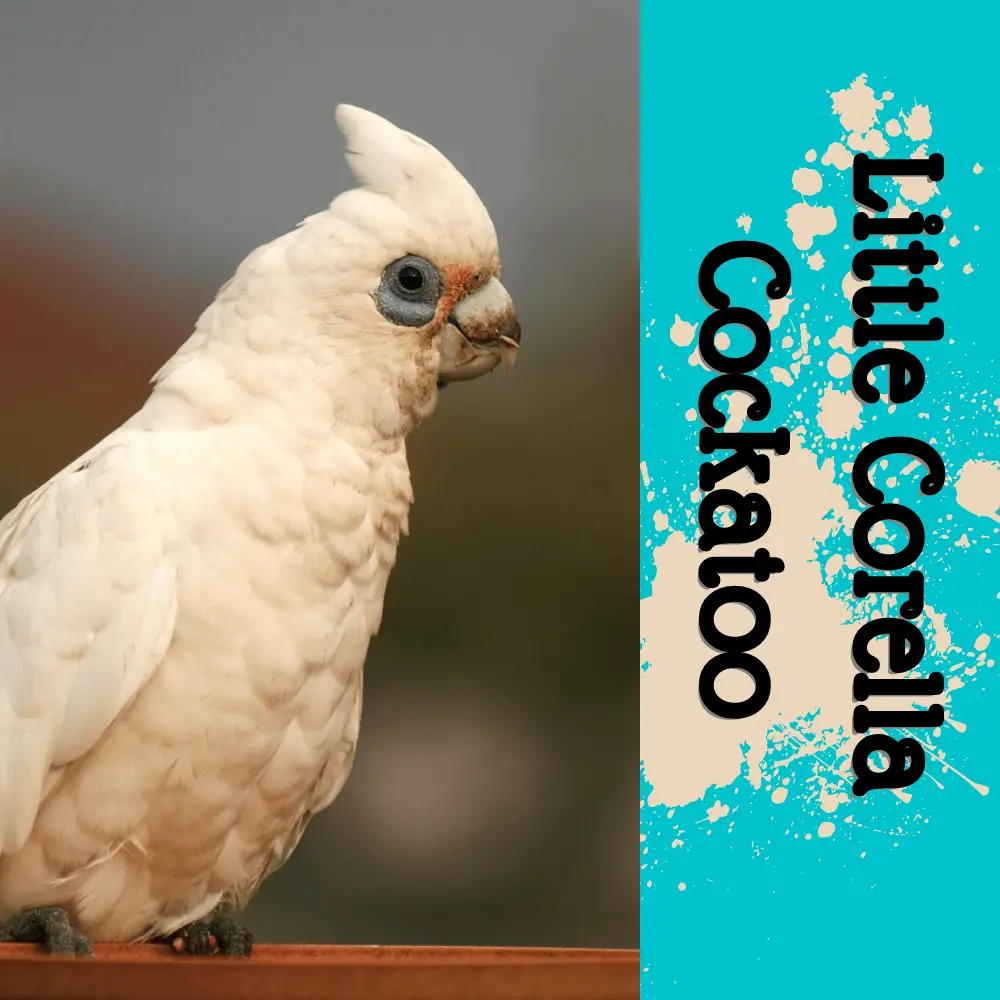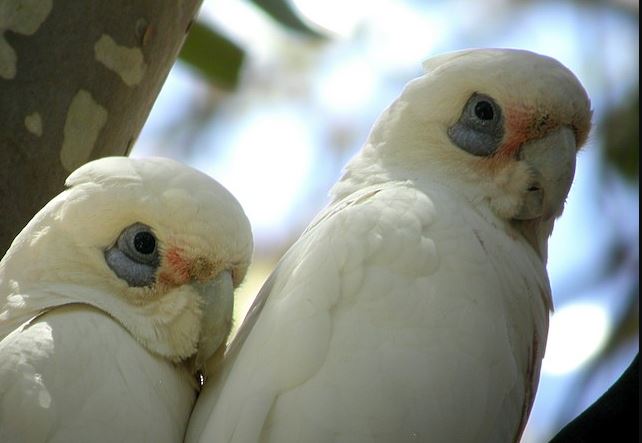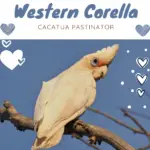
little corella Cacatua sanguinea Scientific name definitions
- LC Least Concern
- Names (16)
- Subspecies (5)
little corella 36–39 cm; 430–580 g; culmen 34 mm. White with medium-length (65 mm) crest and diagnostic short bill; face salmon pink, as are bases of feathers of head and throat that are usually concealed; undersurfaces of wings and tail washed with yellow;
periophthalmic ring blue-grey, wider below the eye; bill bone-colored; eye dark brown in both sexes; legs grey. Sexes similar. Juvenile as adults but periophthalmic ring smaller and paler blue.
Race synopsis has wing and bills shorter general coloration redder; westralensis similar to synopsis but separated by 1000 km; normantoni smaller in all dimensions and very similar to transfreta, but latter has buff underwing coloration.
Systematics History
Editor’s Note: This article requires further editing work to merge existing content into the appropriate Subspecies sections. Please bear with us while this update takes place.

Closely related to C. goffiniana. Sometimes considered conspecific with C. pastinator, and in the past these two treated as conspecific with C. tenuirostris; but current evidence suggests that the three are probably best considered to constitute three separate species.
Has hybridized in the wild with Callocephalon fimbriatum and Eolophus roseicapilla. Race westralensis sometimes subsumed within gymnopis.
Proposed race subdistincta (from Kimberley, in N Western Australia) included within nominate; ashbyi (from Yanco Glen, N of Broken Hill, in W New South Wales) is synonymized with gymnopis. Five subspecies currently recognized.
Watch this BEFORE getting a CORELLA PARROT | 5 Minutes with a Corella
SOURCE: Cockatiel Companion and The Pheasantasiam
Subspecies
Cacatua sanguinea transfreta Scientific name definitions
Distribution
lowland S New Guinea between Kumbe R and lower Fly R.
Cacatua sanguinea sanguinea Scientific name definitions
Distribution
NW Western Australia (Kimberley) and Northern Territory E to the Gulf of Carpentaria.
Cacatua sanguinea westralensis Scientific name definitions
Distribution
WC and C Western Australia.
Cacatua sanguinea gymnopis Scientific name definitions
Distribution
inland C and E Australia (S from NW and C Queensland).
Cacatua sanguinea normantoni Scientific name definitions
Distribution
W Cape York Peninsula (NW Queensland).
Distribution
Editor’s Note: Additional distribution information for this taxon can be found in the ‘Subspecies’ article above. In the future, we will develop a range-wide distribution article.

Habitat
Grassy woodland, scrub, and grassland throughout tropical N and inland semi-arid Australia and S New Guinea.
Movement
A strong flier, traveling long distances to water or too abundant food sources, e.g. a piggery, feed-lot, or grain crop. Some very large flocks assemble, e.g. 32,000 birds at a sorghum crop, Kununurra, Western Australia; in such flocks, members tend to roost together, but the flock breaks up into smaller units for breeding.
SOURCE: Gonebirding G & G
Little corella diet
Seeds of grasses and herbaceous plants, together with shoots, roots, and blossom; also insects and their larvae. Sociable, foraging in large flocks, especially where grain is fed to livestock.
Numbers and range have increased following the widespread provision of water from sub-artesian bores. Most seeds gathered from the ground, but where the plant

little corella cockatoo is robust enough for the bird to land on it (e.g. sorghum), little corella will feed directly on the ear of grain; control is not easy in the latter circumstances since, if bird is disturbed by shooting noise or explosive devices,
little corella will drop the head it is feeding on, fly around a bit, settle again and begin to eat a fresh head, with result that damage can be doubled.
Also feeds from troughs containing grain for livestock. Eats seeds of many different annual and perennial grasses when available.
Little corella call
Flight call is a nasal bisyllabic or trisyllabic “ke-wheh” or “ke-re-weh”, very similar to C. tenuirostris but slightly lower-pitched. Alarm calls include loud screeches and braying sounds.
talking corella angry bird
SOURCE: sparky
Breeding
Laying in the dry season (May-Oct) in the tropics, in spring (Aug–Oct) further S, but May-Oct in South Australia. Nests in tree-hollows; hollow baobabs (Adansonia gregorii) much used in N, whereas elsewhere species typically nests in hollow eucalypts lining watercourses. 2–3 eggs (occasionally 4);
incubation 24–26 days, by both parents; chick has sparse pale yellow down; nestlings remain in the hollow for c. 7 weeks and are fed by both parents. After the young have fledged, the whole family joins a large nomadic foraging flock.
Conservation Status
Conservation status on BirdlifeLC Least Concern
Not globally threatened. CITES II. Common throughout inland and N Australia, frequently attaining pest status where irrigated cereal crops are grown. No definite population figures are available, but species is undoubtedly secure at present. Recently established in Tasmania, where origins of population uncertain.




















